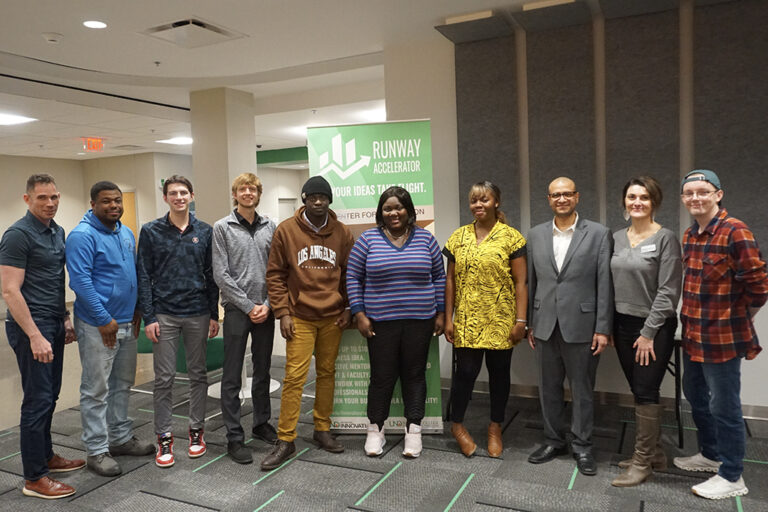Monsters, soothsayers and Cheshire cats, oh my!
Rebecca Bichel, UND dean of libraries, identifies leadership traits in 18:83 Speaker Series talk

In beginning her speech as the most recent person to speak in the 18:83 Speaker Series, Rebecca Bichel, UND’s dean of libraries, said it was a bit intimidating to speak about leadership when she’s standing on a campus full of leaders – and when her boss, UND Provost Eric Link, was sitting in the crowd front and center.
She may have felt tense, but she didn’t show it. She even got the event started off with a laugh with her good-natured quip.
Bichel took the stage at the bottom of the Memorial Union’s Social Stairs to deliver her 18:83 Speaker Series talk on Wednesday, March 20. Each Wednesday, a new executive from UND or the broader community is invited to speak for 18 minutes and 83 seconds — a number that corresponds with UND’s founding year — on the topic of leadership in a “Ted Talk” format.
For her part, Bichel jumped right in to tell the audience that her ideas were not about who she is, but who she hopes to become.
“This is not an autobiography,” she said. “It’s a description of the leader, and more important, the colleague and person I aspire to be.”
Continuing, she offered her definition of what a leader is, followed by several “leadership lessons and legends” that can help people develop their leadership traits.
“I believe leadership is about buy-in and problem solving, optimism and passion for the impact of your work,” she said. “We can all be leaders; we all should be leaders.”
And it turns out that her first “lesson and legend” in leadership, as she showed on a slide, was a cute monster called a BHAG (pronounced “Bee Hag”).
The concept comes from “Good to Great” author Jim Collins and is an acronym for “Big Hairy Audacious Goal.” Leaders, Bichel said, “are monstrously ambitious,” but for institutional success more than their own. To achieve that success, they need to have a BHAG, and the passion to realize it.
A strong example of a BHAG, she said, was U.S. President John F. Kennedy’s determination to put a person on the moon.
At work, Bichel routinely interacts with students who are ambitious in pursuing the education needed for their careers, she noted. These students have their own BHAGs.
The next lesson, and apropos of a person working in a library, Bichel said she learned from the Cheshire cat in Lewis Carroll’s “Alice’s Adventures in Wonderland.”
In that story, when the lost Alice wonders where she should go, the cat tells her that depends a great deal on where she wants to go. Alice responds that she doesn’t care where, as long as she gets somewhere, to which the cat responded that in that case, it doesn’t really matter where she goes.
“My takeaway is that without a goal, any path will do,” Bichel said.
Bichel’s leadership lessons and legends also include:
- Leaders are for real (and she showed on screen a meme of Jeff Bridges in character as The Dude from the movie “The Big Lebowski,” asking, “Are you for real?”). That means they are genuine people. And they DON’T try to correct their mother’s grammar, lest their mother give them a lesson in humility, another necessary trait for a genuine person.
- Leaders are collaborative. They build strong teams and work to unlock the potential in each member.
- Leaders are optimistic. They can remain that way by believing in the meaningfulness of their purpose and their colleagues.
- Leaders are resilient, and failure is critical to success. Failure is the reason for the existence of Dairy Queen ice cream — in other words, it’s what you eat after a failure, she said. And after eating that ice cream and acknowledging their failure, good leaders get back on their feet and put the failure behind them.
- Leaders are experiential learners; that is to say, they learn by doing. They have more tools in their leadership toolboxes than a hammer and can understand that different problems require different solutions.
- Leaders are trusting.
And finally, leaders are soothsayers, she said. Soothsayers predict the future by magic, intuition or other rational means. Leaders must look to the future to be ready to lead change, when change is needed.
“I don’t have a crystal ball; I can’t do magic,” she said. “But I do believe that leaders must always be looking to the future, thinking about future opportunities and challenges using data to make educated predictions.”
The 18:83 Speaker Series continues Wednesday, March 27, with Meloney Linder, UND vice president of Marketing & Communications.



